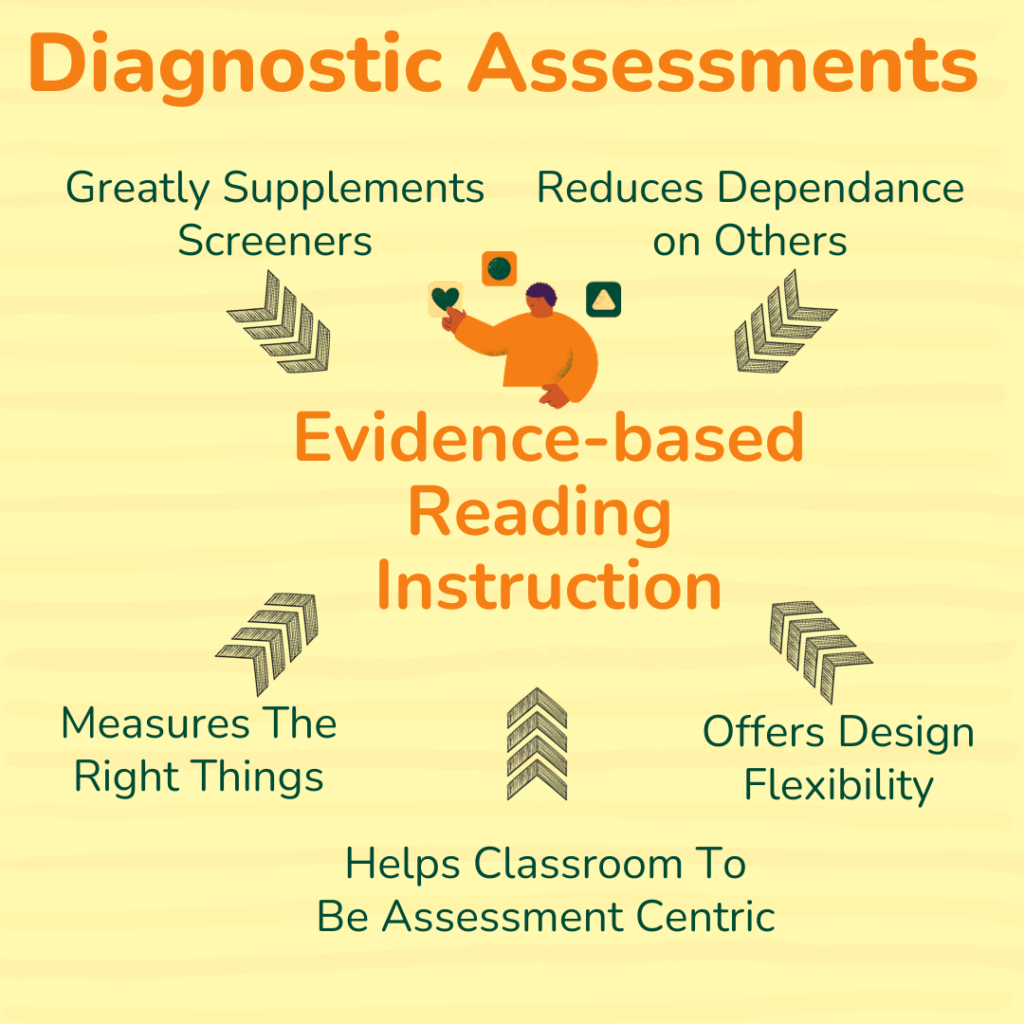Sprig Learning covers all the intricacies of early literacy assessments in its blog, providing valuable insights for educators.
Previous articles demystify the distinctions between formal and informal assessments, offering a valuable resource for teachers seeking a balanced approach in their classrooms.
They venture into the future of assessments, embracing a holistic perspective that considers various facets of a child’s learning experience.
They further delve into the nuanced parameters involved in assessment design.
Sprig is passionate about assessments and their profound impact on a young learner’s educational journey. With the same dedication, this article explores the indispensable role of diagnostic assessments in shaping evidence-based literacy instruction.
This is part of a two-part series on the qualities of diagnostic assessments.
Diagnostic assessments are typically administered at the outset of a school year, term, semester, or teaching unit. Serving as essential tools for teachers, these assessments play a crucial role in planning instruction and establishing precise learning goals.
They offer valuable insights, empowering both teachers and students to assess existing knowledge and skills related to overall and specific expectations.
Diagnostic assessments embody five powerful qualities that make them powerful drivers of evidence-based early literacy instruction, meeting the pressing needs of teachers in today’s educational landscape.
They Are As Follows:

1. Greatly Supplements Screeners
Timely screening and early diagnosis are recognized as pivotal factors in shaping early literacy outcomes, standing out among the six key strategies for making a difference in early literacy. Screening tools play a crucial role in swiftly identifying students requiring additional support. However, the effectiveness of tier 1 instruction raises a compelling question: do these students, after exposure to robust classroom teaching, still require the same level of assistance?
Or what about those students that the screener did not identify as needing support but who are bound to fall through the cracks due to lack of engagement in the classroom or an inability to absorb the required learning concepts.
This is where diagnostic assessments step in, offering invaluable insights to determine the ongoing needs of students and ensuring that intervention aligns precisely with their evolving requirements.
2. Reduces Dependence on Others
Teachers frequently turn to literacy coaches and other specialists for assessment guidance. Diagnostic assessments streamline this process as they are designed to be specific in evaluating targeted skills, aligning closely with the curriculum in use.
While collaboration among teachers and early literacy specialists remains essential, the beauty of diagnostic assessments lies in their ability to empower teachers to assess their students without unnecessary barriers.
In fact, insights 15 to 20 from 40 Science of Reading Insights deal with leadership practices that significantly raise the percentage of students’ reading at-grade level by Grade 2. What stands out in particular is “empowering teachers to own and lead interventions” and “sharing granular data with students”.
By fostering a culture of diagnostic assessments, teachers undergo training to consistently diagnose their students on highly specific skills, such as the foundational reading skills. This empowers them to be deliberate in their teaching practices, encompassing instruction, assessment, and intervention with precision.
3. Measures The Right Things
Diagnostic assessments adopt the right perspective on academic return on investment. Like any investment, the return should ideally enhance student learning and teacher effectiveness.
These assessments diagnose specific units of learning, validated by extensive research to contribute significantly to reading proficiency. This proficiency can be viewed as a substantial output or return for any school system aiming to address the learning needs of its students!
4. Helps Classroom to Be Assessment Centric
Barring progress monitoring assessments, diagnostic assessments are the most frequently employed in classrooms. This emphasis on assessment-centric classrooms aligns with one of the four ideal classroom characteristics identified by The University of Pennsylvania’s Penn Literacy Network, based on meta-research supporting early literacy best practices that lead to enhanced student achievement.
Indeed, this quality of being assessment-centric plays a pivotal role in reinforcing all other essential classroom characteristics—student-centricity, knowledge-centricity, and reflection-centricity.
Especially when it comes to knowledge-centricity, it entails grasping the significance of reading and establishing connections between acquired knowledge and its application in reading.
Diagnostic assessments, along with subsequent progress monitoring assessments, facilitate this by offering ongoing tracking of all the subskills measured at specific intervals.
5. Offers Design Flexibility
Designing effective assessments in early childhood education involves careful consideration of both content and structure. The content of assessments focuses on what is being measured, while the structure deals with how that content is assessed and the manner in which information is stored.
In the context of diagnostic assessments, teachers can gather information by assigning tasks to students, maintaining individual portfolios that document developmental progress, and utilizing rubrics to assess and evaluate students’ comprehension of taught concepts.
This flexibility and teacher autonomy afforded by diagnostic assessments empower educators to tailor the educational experience to best suit the needs of their students.
Use Diagnostic Assessments to Drive Evidence-based Instruction

The regular assessment of learning is listed as one of the major uses of the Elementary and Secondary School Emergency Relief Fund . It’s concerning that about 70% of U.S. educators lack access to high-quality, standards-aligned curriculum.
It underscores the importance of ensuring curricula align with state academic standards and incorporate embedded assessments for monitoring progress.
This dual need emphasizes the requirement for both top-notch instructional materials and a systematic assessment process to measure and monitor student learning.
Navigating the assessment landscape involves various considerations, including the formality of assessments, the exploration of holistic formative assessments, and efforts to reduce bias. Each of these topics is covered in separate articles written by Sprig, linked above.
However, in the current era, marked by a focus on evidence-based literacy mandates and the adoption of strategies for effective implementation, assessments must align with the measurement of explicitly and systematically taught foundational reading skills.
Sprig aims for the drivers outlined in this article to serve as compelling reasons for including diagnostic assessments in your assessment toolbox.
Stay tuned for part 2 of this article, which will uncover more intriguing insights about diagnostic assessments.

